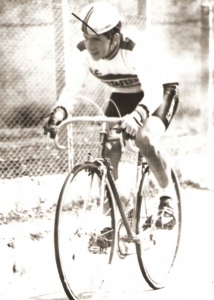
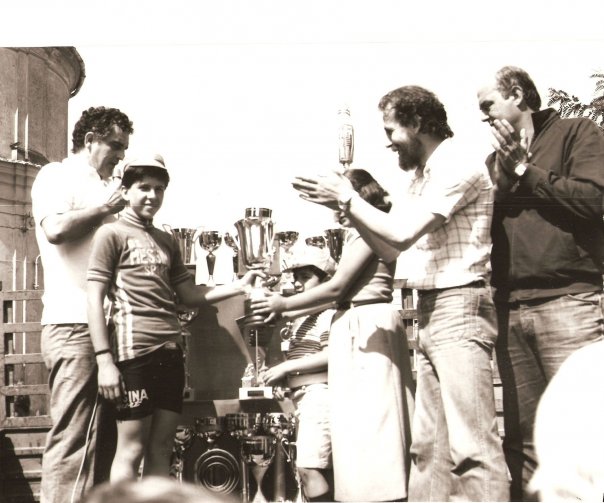
"Alessandro Matteucci was born and raised in Rome, he is always happy to sit down for a chat with an espresso or cappuccino proclaims the Italian School of Cycling’s website."
Truth, but not the whole truth. What it neglects to say is he is a wily and aggressive competitor, constantly picking the correct moves to be in and rarely finishing outside of the top 10 in any race he enters. How does he manage this? Good coaching and race experience, something he hopes his school can help teach it’s students. Today, we sit down to chat with him about his school, racing and coaching lineage and his views on la vita/l’universo/e tutto (quarantadue).
NYVC: Give us some background on your introduction to the sport growing up in Rome,
AM: I was 11 and I got a road bicycle as communion present from my grandmother, after my father and her had noticed my passion for the two wheels. I started racing with a local team when I was 12 and from then on, road racing became my life, until I turned 19.
NYVC: What gives Italian cycling its unique character?
AM: In every country cycling is the result of a few variables such as the morphology of the
terrain, traffic, sport infrastructures, type of races and of course the tradition behind it.
Italy is a very small country but we have a great variety of terrain so it is easy to climb
mountains, ride rolling hills as well as cover long distances on the flat. Cycling until
the ‘60-‘70s was probably with soccer the most important sport in Italy and we had
great velodromes in Rome and in Milan. Over the years, Italians have won the Road
World Championship more than anybody else, with the exception of Belgium. Racers
as Coppi, Bartali, Gimondi, Moser, Pantani and Cipollini are sport legends, athletes
whose achievements have inspired cycling all around the world. In the past century,
Italy has also become famous in cycling for its manufacturers: Colnago, Pinarello,
Willier Triestina, Bianchi – these are just a few names, but until 20 years ago, in every
town in Italy we had great artisans who were building frames in steel or aluminum with
techniques and geometries that they were passed on from father to son. Unfortunately,
cycling has been declining in my country because of traffic on the roads and lack of
infrastructures to guarantee safety in training for very young athletes. The tradition is
still very strong in Tuscany and a few other regions in North Italy, but if things do not
improve, eventually Italy will loose its identity in the sport for a lack of new champions.
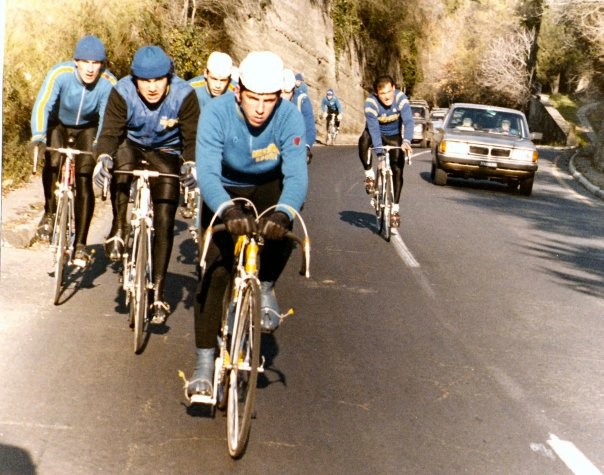
NYVC: What brought you to NYC?
AM: After earning a degree in Business and Economics in 1995 for sentimental reasons I
decided to move to the USA. I ended up working 13 years on Wall Street and fours
years ago I turned to bicycle coaching after having been laid off during the recession.
Before then, for 10 years I had been a road racer motorcycle instructor for some of the
most important clubs in the North East, and during that time I developed my passion for
coaching. When I was laid off, I had just started racing bicycles and some fellow racers
who I was helping in training and racing told me to become a bicycle coach because “I
had it”! At beginning it was a bit strange to leave the corporate world for this kind of
career, but now I do love it and I cannot even imagine doing anything else.
NYVC: How do you find the racing here in NY, how is it different than what you had
experienced at home?
AM: As I have mentioned, I started racing at 12, so my bike had gear limitations. I am not
quite sure but I think that the longest gear was 49×19 or something similar. The result
was that at every race there were 60 to 100 young racers spinning at an average of
130rpm: nobody could breakaway in those conditions. We were forced to stay covered in the belly of the group, somehow surfing from one surge to another one until the very last move where you had to outsprint, or better, to outspin your competitors off their draft. So
the common denominator in my first few years of racing was riding elbow to elbow
through corners and sometime cobblestones. All the kids were forced to develop a
minimum common level of riding skills to be competitive, so racing was intense but safe.
Here in NYC the average rider, in the best scenario, starts racing in the mid 20s mainly in
the two parks and FBF. The pelotons in the Cat 5 and 4 are quite dangerous for the mixed
bag of skills in place. Everybody reacts in his or her own way to the same type of
obstacle or challenge. Because of the downhills and absence of corners in both parks, it is
very difficult to stretch the peloton so most of the time it comes down to a field sprint
and crashes are very common. The typical dynamic is the following: we get all together
to the last km with no organized team train pulling at the front and then you have the non-
sprinters trying to jump ahead but 20-30 seconds into the effort they are coming back in
reverse causing mayhem in the group because someone will hit the breaks hard while
someone else will move on the side towards the ominous jogger lane causing further hard
breaking actions and swerving. Eventually a wheel will be overlapped or someone will
end up tangling with another rider creating the beginning of the crash. While in Central
Park the “S” before Cat Paw finish line causes extra nervousness, in Prospect Park it is
the downhill that causes the problem: racers can sit in without pedaling for 1 minute or so
right before the final sprint, so there is no selection. If I were the organizer of the races in
PP, I would move the finish on to the flat area after the hill or what we call the PP KOM.
You will have a spectacular and safe finish with racers trying to get away from the
bottom of the hill and consequently the peloton would be stretch over a long distance.
Also we will not see the same sprinters winning over and over, because most likely when
everybody is forced to stick his or her nose in the wind for 1 mile you will be surprised at
the outcome. I can imagine that it is not easy to deal with the all the park regulations
about where to organize the start/finish of a cycling race but I believe that safety should
be the main concern for the park authorities as well as the race organizers.
Also, racing mainly in the parks does not highlight the importance of drafting: the
whirlpool effect generated by the trees while going around a circle hides the need to stay
covered in the draft. No wonder that even when we race in a square-course-open-field
as FBF with very strong winds we do not see any echelon, with the rare exception of
successful small breakaways in the Cat 1.2.3. race. In FBF with strong lateral wind it is
very common to see everybody in single file riding next to the curb, near the grass and
bushes even when following teammates.
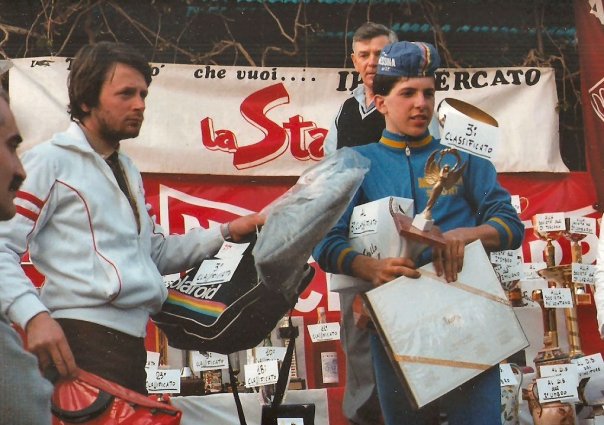
What racing in NYC and Italy have in common is definitely the passion for the sport: the
level of commitment to cycling in NYC despite the weather, the traffic, the limited choice
of bicycle routes, is unbelievable! When I moved here in 1995 and I saw people riding
on bicycle paths near the water, going around joggers, strollers, roller-blades and tourists
I said to myself that it would have been impossible to be a racer in NYC. Not only I was
wrong, but here I am being a professional bicycle coach in NYC!
NYVC: Has American cycling culture caught up with Europe?
AM: Lemond, Armstrong and nowadays Taylor Phinney who lives in Lucca, Tuscany, have
done so much in creating a bridge of culture and tradition in cycling between USA and
Europe. Of course, winning a Tour of California is not as rewarding as a Tour de France
or Giro di Italia, but the fact that some pro tour teams train and race here tells you how
important the American market has become at worldwide level. I foresee that in the
future it will become more “normal” for Europeans and Americans to travel abroad to
race and bike tour the in the different countries.
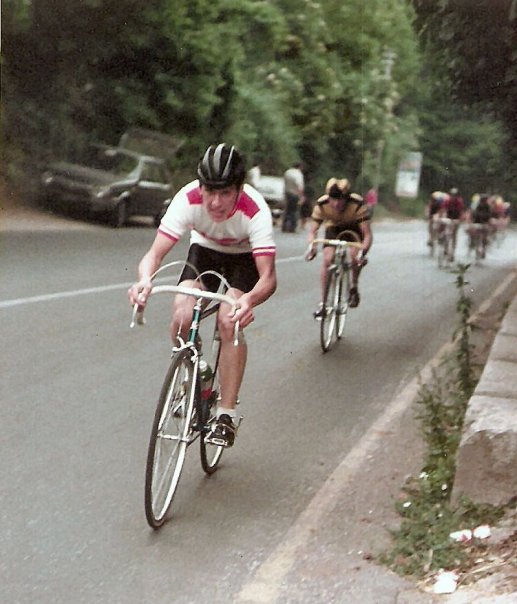
NYVC: What have you learned growing up in the sport in Italy that you think Americans
can learn from?
AM: I have learned the art of racing, the ability to use the peloton, to play all different kind of strategies to be competitive even when you are not the best. The main goal for a master racer should be to learn the skills since in the long run it is the most rewarding direction to grow. Physical performance and race results are very much related to the time invested in training. But not everybody can ride for several hours during weekdays and very often family and professional responsibilities make it difficult to commit to the sport at high level for several seasons. So at the end, to become a classy racer, someone who even with 10 extra pounds could feel very comfortable in a fast group ride or race, regardless of his or her age, could be very rewarding.
NYVC: Do you think Americans, or American style cycling coaches are too concerned about
data, power numbers and spread sheets and miss some of the nuances of the coaches
you grew up with?
AM: My ex coach and mentor is Antonio Fradusco, today one of the best coaches in Italy for
juniors, with over 30 years of coaching experience after being a very successful racer
himself. He represents very well the evolution of coaching in the past few decades.
When I started racing team managers and coaches were guys in the late 60s, people
that had witnessed and raced epic cycling events. They represented a living know-how
about the sport. They knew the secrets of training because there was very little literature
available at that time. The training was based only on the experience and the natural
ability of “reading” somehow the athlete’s performance. Anyhow Italy, beside its road
racer champions, is the country of sport genius doctors such as Conconi and the infamous
Ferrari, doctors who have affected cycling in an indelible way for the good or the bad
of the sport. Talking about Conconi, my coach Antonio Fradusco was performing the
Conconi test with us back in 1984, the same year that Francesco Moser won the World
Hour Record basing his training on the same test. I remember that our heart rate monitor
was as big as a kid’s shoes box and we were measuring the distance with a device
attached to the hub by a rubber band. The speed was calculated only after the test and
the heart rate values were yelled to Antonio at the end of each loop! 28 years have gone
by, but we still use heart rate readings for certain kind of training, along with the more
modern approach based on power meters and watts.
So to answer your last question, yes here in USA very often I notice too much emphasis
on the data and not enough attention to the efficiency of the rider at different levels. If the
race is a TT or characterized by very long climbs, of course the physical performance of
the athlete becomes very critical, but anytime there is a group of racers, the smartest and
most experienced wins, not necessarily the strongest. It does not matter to have a race
car with a powerful engine if it cannot be driven properly. I see power profiles of racers
who could be big time winners but the truth is that they are not because they are leaking
watts everywhere during the competition. As bicycle coach my main goal is always to
transform a “pedaler”, even a strong pedaler, into a Racer, yes with the capitol “r”.
NYVC: What have you learned about racing here in NYC?
AM: I have learned about the magic of our sport. In Italy when I started racing the majority
of racers belonged to the low and the middle class. It was not a sport for rich people. In
NYC I have met, worked and raced with people from every walk of life. Once we wear
our kits, it does not matter if we are rich or not, the color of our skin, male or female: we
are racers, people in love with our sport. Road racing, from this point of view it is a great
social equalizer and something that could have wonderful effects in the community in the
long run.
To find out more about Alessandro’s coaching visit:
www.italianschoolofcycling.com
347.452.0069

Alessandro is a great rider with a true pedigree….ride with him for 10 minutes and it’s obvious.
nice interview. if you ever run into him on the road, Ale has some great stories.
Always sitting on. Never pulling through.
great interview with a great guy
great stuff – confirms what I figured out by leaving nyc. people don’t know how to race there
Nice interview. But instead of complaining about no team taking control of the sprint why not have your own BH teammates do it or are they too busy worrying about the doping controls?
come on, there is a great deal of strategy in central park races. the timing of the morning grumper, for example. is it 4 a.m.? 4:30? it can often mean the difference between placing or sharting on harlem hill.
Grumper is a new one to me. Do you mean growler?
I like both of his ideas, one for the finish of the race on top of the hill and even the long stretch idea. Take it from someone who rode and raced in Prospect for years. And won a few!
Typical Masters Type A D Bag.
Very much enjoyed reading this interview and brought back great memories of a few dinners and conversations with Alessandro. Sempre un grande.
This is the first time i am hearing his name probably. But i have turned into a fan of his just fashion for play after reading this. He is quite a genius isn’t he? I think it is his will to succeed that brought him to such great heights.